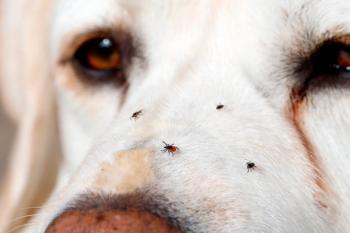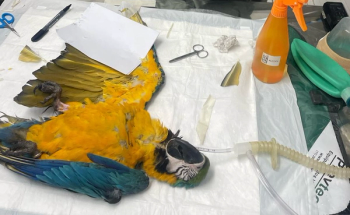
The rise of infectious disease
Annual veterinary report on the state of pet health calls increases in FIV and Lyme disease 'staggering.'
The Banfield Pet Hospital annual State of Pet Health Report for 2014 focuses on what it calls a “staggering” increase in infectious diseases in dogs and cats. Data from patients at Banfield’s 850 hospitals—470,000 cats and 2.3 million dogs in 2013—showed a 48 percent increase in the prevalence of feline immunodeficiency virus (FIV) in cats and a 21 percent increase in the prevalence of infection with the bacterium that causes Lyme disease in dogs since 2009. The hospitals’ internal research team, Banfield Applied Research and Knowledge (BARK), also studied trends involving parvovirus, Giardia infection and kennel cough in dogs and feline leukemia virus (FeLV), upper respiratory infection and ear mites in cats.
“They’re not all rising, but the [diseases] that are rising have a huge impact on pets,” says Banfield senior researcher Sandy Lefebvre, DVM. Most alarming, she says, is the increase in FIV. “The truth is, we really don’t know why this is happening. It’s not because we tested more cats—we haven’t.”
She says spay and neuter rates weren’t a factor in the increase—the virus is more common in intact cats as they mate and fight, making them more susceptible. “Maybe more cats are going outside than they used to; maybe the virus is getting more infectious; could mean that there’s more of it out there,” Lefebvre says. “We just don’t know.”
Cat owners may not understand the risk of exposure for cats that go outdoors or in multiple cat households where one newly introduced cat can spread the disease to all. And dog owners may not grasp the accelerated risk for Lyme disease, Lefebvre says. “We actually have information that the prevalence of tick infestation was increasing over the same period as the State of Pet Health Report—because there are more ticks, more dogs are getting infected,” she says. “Population of white tail deer are getting larger—with more deer around and with deer venturing into people’s backyards, the opportunity to spread Lyme disease is even greater.”
Part of the problem is that pet owners literally don’t see the danger. “Ticks are so hard to see,” Lefebvre says. “People assume they let their dogs out in the backyard and they’re safe. They need to be aware that there are dangers out there and they need to take precautions.”
The State of Pet Health report also shines a light on the threat of other infectious diseases that exists in seemingly innocent and regular activities for pets. Cats can come into contact with the parasite that causes toxoplasmosis from eating infected animals such as mice. Dogs can contract leptospirosis by licking contaminated urine—easily achieved at a dog park. Banfield believes the trends uncovered in the 2014 report illustrate the value of preventive pet healthcare to reduce the risk of disease in pets.
For example, feline upper respiratory infection increased 18 percent in the past five years. Lefebvre says that’s disappointing. “The increase is unnecessary given the available vaccines to prevent these infections,” she says. “I think what might be happening is that they get the first round of vaccines, but then they don’t return to get boosters.”
But there is good news in the report as well. While the Bayer Veterinary Care Usage
Study has reported that feline visits are steadily declining, Banfield data shows its cat visits increasing annually. Cat patients visited Banfield veterinarians approximately 2.2 times in 2013, up 7 percent from 2009. Lefebvre attributes this to Banfield’s wellness plan, which includes unlimited office visits for patients. “The wellness plan is the difference,” she says. “It’s just easier to bring your pet in.”
Lefebvre says the goal of the report is to educate pet owners and encourage them to visit their veterinarian to make sure vaccinations are up to date and antiparasite medication is given regularly. “It’s been a really long winter; it’s natural to want to go outside with your pets,” Lefebvre says—but pet owners need to be constantly aware of potential dangers. “Keep [pets] away from feces and possibly contaminated water in puddles and ponds. Particularly in a dog park, people don’t announce if they’ve been vaccinated.”
Here’s what veterinarians and their clients should know about the current risk of infection in dogs and cats.
Dogs
> Approximately one in every 130 dogs was infected with the bacterium that causes Lyme disease.
> Northeastern states are a hot spot of Lyme disease, specifically New Hampshire, where one in every 15 dogs seen was infected.
> Lyme disease was twice as common in large breed dogs as in toy or small breed dogs.
> About one in every 290 dogs tested positive for canine parvovirus at Banfield hospitals in 2013.
> Dogs in New Mexico, Texas and Nevada had the highest rate of parvovirus infection.
> Puppies are at greatest risk of parvovirus infection—one in every 74 puppies was infected.
> Intact dogs 1 year and older were almost 23 times as likely to be infected with parvovirus as spayed or neutered dogs of the same age.
> Approximately one in every 230 dogs had a Giardia infection in 2013.> Giardia was most common in dogs living in the central and northeastern United States.
> Kennel cough remains a significant threat despite the availability of effective vaccines; the disease affected almost 2 percent of dogs seen in 2013.> Kennel cough was most often diagnosed in Kentucky, Utah and Florida.
Cats
> Approximately one in every 300 cats seen in Banfield hospitals in 2013 was infected with FIV.
> The most FIV infection were in Oklahoma, Iowa and Arkansas.
> Male cats are three times as likely to be infected with FIV as females.
> Intact cats older than 1 year were 3.5 times as likely to be infected with FIV as same-aged spayed or neutered cats.
> In 2013, approximately one in every 250 cats was infected with FeLV.
> Cats in Idaho, Alabama, South Carolina and Louisiana had the highest rate of FeLV infection.
> Eighteen percent of juvenile cats had an upper respiratory infection—making this age group three times as likely to be diagnosed with the disease compared with older cats.
> About one in every seven cats seen in Kentucky had an upper respiratory infection.
> Overall, 10 percent of cats seen had upper respiratory infections in 2013.> Approximately one of every 45 cats seen in 2013 had ear mites.
> Juvenile cats were more than eight times more likely to have ear mites than cats older than 1 year of age.
Newsletter
From exam room tips to practice management insights, get trusted veterinary news delivered straight to your inbox—subscribe to dvm360.






